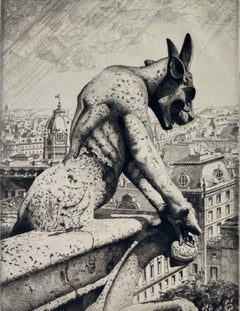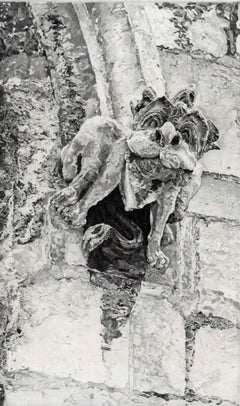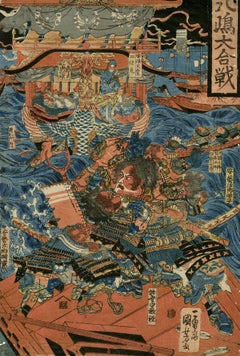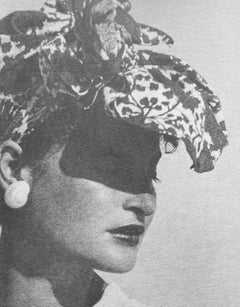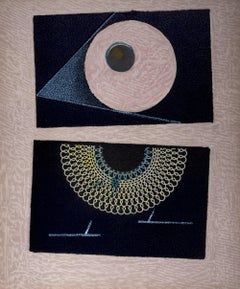Accessories Landscape Prints
to
13
19
4
3
3
2
Overall Width
to
Overall Height
to
9
9
3
1
1
2
2
1
1
1
2
22
7
3
2
3
2
5
3
16
11
3
2,596
6,862
3,380
2,629
2,380
1,879
1,670
1,514
1,394
1,233
1,055
1,028
999
871
860
844
733
582
534
531
11
7
7
3
3
1
6
19
11
Art Subject: Accessories
Surrealist Lovers - Signed Facsimile, Ltd /450
By M.C. Escher
Located in Paris, IDF
M.C. ESCHER (1898-1972)
Surrealist Lovers, 2008
Facsimile after the original woodcut from 1935
Signed in the plate
Numbered / 450 copies (the number you can see can be different)
On...
Category
20th Century Modern Landscape Prints
Materials
Color
The Gargoyle and His Quarry
Located in Storrs, CT
The Gargoyle and His Quarry, Notre Dame. 1920. Etching.Fletcher 90. 7 1/8 x 5 1/4 (sheet 10 1/2 x 9 1/16). Gargoyle series #1. Edition 75. A rich impression printed on 'FJHead&Co' c...
Category
1920s American Modern Landscape Prints
Materials
Drypoint, Etching
$2,750 Sale Price
21% Off
The Gothic Spirit
Located in Storrs, CT
The Gothic Spirit (also called A Gargoyle, A Gothic Spirit). 1922. Etching and stipple. Fletcher 120. 11 5/8 x 7 (sheet 15 1/4 x 11 1/4). Gargoyle Series #8. Edition 130. Illustrated...
Category
1920s American Modern Landscape Prints
Materials
Drypoint, Etching
$2,500 Sale Price
28% Off
The Battle of Dan-no-ura in Yashima, Nagato Province in the First Year .....
Located in Middletown, NY
The Battle of Dan-no-ura in Yashima, Nagato Province in the First Year of the Bunji Era (1185)
Tokyo c. 1830
Woodblock print (nishiki-e) with ink and hand-coloring in watercolor on handmade mulberry paper, 14 7/16 x 9 15/16 inches (367 x 252 mm), ōban tate-e, the full sheet. In good condition with some handling creases. Colors are fresh and extremely vibrant. The right panel from the triptych by Yoshitora depicting one of Japan's most storied naval battles. An impression of this work may be found in the permanent collection of the Honolulu Museum of Art.
The great naval battle of Dan-no-ura in 1185 was the final climax in a long series of bitter wars between two powerful families in feudal Japan...
Category
Early 19th Century Edo Figurative Prints
Materials
Watercolor, Handmade Paper, Woodcut
Man Ray, Composition, Man Ray (after)
By Man Ray
Located in Southampton, NY
Lithograph on vélin paper. Inscription: unsigned and unnumbered, as issued. Good condition. Notes: From the folio, Man Ray, 1984. Published by Centre National des Arts Plastiques, Ni...
Category
1980s Surrealist Figurative Prints
Materials
Lithograph
$716 Sale Price
20% Off
Ernst, Composition (Monod 2619; Spies/Leppien A19/C), Dent Prompte (after)
By Max Ernst
Located in Southampton, NY
Lithograph on vélin d’Arches paper. Inscription: unsigned and unnumbered, as issued. Good condition. Notes: From the folio, Dent Prompte, Dix poèmes inédits illustrés par Max Ernst, ...
Category
1960s Surrealist Landscape Prints
Materials
Lithograph
$716 Sale Price
52% Off
"Jungle, " Color Lithograph Landscape signed by Carol Summers
Located in Milwaukee, WI
"Jungle" is an important, rare color lithograph signed by Carol Summers from the early years of his production. The image offers a landscape of a dark jungle, printed mostly in black ink. In the center, a blue pool of water is shaded by two trees. Summers' technique in this print renders a painterly quality to the image: the grasses and leaves of the scene are all created with playful, energetic swiping motions much like watercolor paint. This technique and the use of fields of color predict the style Summers would adopt in the coming decades, making this an important early work.
30 x 22 inches, artwork
Numbered 14 of the edition of 27
Carol Summers (1925-2016) has worked as an artist throughout the second half of the 20th century and into the first years of the next, outliving most of his mid-century modernist peers. Initially trained as a painter, Summers was drawn to color woodcuts around 1950 and it became his specialty thereafter. Over the years he has developed a process and style that is both innovative and readily recognizable. His art is known for it’s large scale, saturated fields of bold color, semi-abstract treatment of landscapes from around the world and a luminescent quality achieved through a printmaking process he invented.
In a career that has extended over half a century, Summers has hand-pulled approximately 245 woodcuts in editions that have typically run from 25 to 100 in number. His talent was both inherited and learned. Born in 1925 in Kingston, a small town in upstate New York, Summers was raised in nearby Woodstock with his older sister, Mary. His parents were both artists who had met in art school in St. Louis. During the Great Depression, when Carol was growing up, his father supported the family as a medical illustrator until he could return to painting. His mother was a watercolorist and also quite knowledgeable about the different kinds of papers used for various kinds of painting. Many years later, Summers would paint or print on thinly textured paper originally collected by his mother.
From 1948 to 1951, Carol Summers trained in the classical fine and studio arts at Bard College and at the Art Students League of New York. He studied painting with Steven Hirsh and printmaking with Louis Schanker. He admired the shapes and colors favored by early modernists Paul Klee (Sw: 1879-1940) and Matt Phillips (Am: b.1927- ). After graduating, Summers quit working as a part-time carpenter and cabinetmaker (which had supported his schooling and living expenses) to focus fulltime on art. That same year, an early abstract, Bridge No. 1 was selected for a Purchase Prize in a competition sponsored by the Brooklyn Museum.
In 1952, his work (Cathedral, Construction and Icarus) was shown the first time at the Museum of Modern Art in New York City in an exhibition of American woodcuts. In 1954, Summers received a grant from the Italian government to study for a year in Italy. Woodcuts completed soon after his arrival there were almost all editions of only 8 to 25 prints, small in size, architectural in content and black and white in color. The most well-known are Siennese Landscape and Little Landscape, which depicted the area near where he resided. Summers extended this trip three more years, a decision which would have significant impact on choices of subject matter and color in the coming decade.
After returning from Europe, Summers’ images continued to feature historical landmarks and events from Italy as well as from France, Spain and Greece. However, as evidenced in Aetna’s Dream, Worldwind and Arch of Triumph, a new look prevailed. These woodcuts were larger in size and in color. Some incorporated metal leaf in the creation of a collage and Summers even experimented with silkscreening. Editions were now between 20 and 50 prints in number. Most importantly, Summers employed his rubbing technique for the first time in the creation of Fantastic Garden in late 1957.
Dark Vision of Xerxes, a benchmark for Summers, was the first woodcut where Summers experimented using mineral spirits as part of his printmaking process. A Fulbright Grant as well as Fellowships from the Louis Comfort Tiffany Foundation and the Guggenheim Foundation followed soon thereafter, as did faculty positions at colleges and universities primarily in New York and Pennsylvania. During this period he married a dancer named Elaine Smithers with whom he had one son, Kyle. Around this same time, along with fellow artist Leonard Baskin, Summers pioneered what is now referred to as the “monumental” woodcut. This term was coined in the early 1960s to denote woodcuts that were dramatically bigger than those previously created in earlier years, ones that were limited in size mostly by the size of small hand-presses. While Baskin chose figurative subject matter, serious in nature and rendered with thick, striated lines, Summers rendered much less somber images preferring to emphasize shape and color; his subject matter approached abstraction but was always firmly rooted in the landscape.
In addition to working in this new, larger scale, Summers simultaneously refined a printmaking process which would eventually be called the “Carol Summers Method” or the “ Carol Summers Technique”. Summers produces his woodcuts by hand, usually from one or more blocks of quarter-inch pine, using oil-based printing inks and porous mulberry papers. His woodcuts reveal a sensitivity to wood especially its absorptive qualities and the subtleties of the grain. In several of his woodcuts throughout his career he has used the undulating, grainy patterns of a large wood plank to portray a flowing river or tumbling waterfall. The best examples of this are Dream, done in 1965 and the later Flash Flood Escalante, in 2003. In the majority of his woodcuts, Summers makes the blocks slightly larger than the paper so the image and color will bleed off the edge.
Before printing, he centers a dry sheet of paper over the top of the cut wood block or blocks, securing it with giant clips. Then he rolls the ink directly on the front of the sheet of paper and pressing down onto the dry wood block or reassembled group of blocks. Summers is technically very proficient; the inks are thoroughly saturated onto the surface of the paper but they do not run into each other. The precision of the color inking in Constantine’s Dream in 1969 and Rainbow Glacier in 1970 has been referred to in various studio handbooks. Summers refers to his own printing technique as “rubbing”. In traditional woodcut printing, including the Japanese method, the ink is applied directly onto the block. However, by following his own method, Summers has avoided the mirror-reversed image of a conventional print and it has given him the control over the precise amount of ink that he wants on the paper. After the ink is applied to the front of the paper, Summers sprays it with mineral spirits, which act as a thinning agent. The absorptive fibers of the paper draw the thinned ink away from the surface softening the shapes and diffusing and muting the colors. This produces a unique glow that is a hallmark of the Summers printmaking technique. Unlike the works of other color field artists or modernists of the time, this new technique made Summers’ extreme simplification and flat color areas anything but hard-edged or coldly impersonal.
By the 1960s, Summers had developed a personal way of coloring and printing and was not afraid of hard work, doing the cutting, inking and pulling himself. In 1964, at the age of 38, Summers’ work was exhibited for a second time at the Museum of Modern Art. This time his work was featured in a one-man show and then as one of MOMA’s two-year traveling exhibitions which toured throughout the United States. In subsequent years, Summers’ works would be exhibited and acquired for the permanent collections of multiple museums throughout the United States, Europe and Asia. Summers’ familiarity with landscapes throughout the world is firsthand. As a navigator-bombardier in the Marines in World War II, he toured the South Pacific and Asia.
Following college, travel in Europe and subsequent teaching positions, in 1972, after 47 years on the East Coast, Carol Summers moved permanently to Bonny Doon in the Santa Cruz Mountains in Northern California. There met his second wife, Joan Ward Toth, a textile artist who died in 1998; and it was here his second son, Ethan was born. During the years that followed this relocation, Summers’ choice of subject matter became more diverse although it retained the positive, mostly life-affirming quality that had existed from the beginning. Images now included moons, comets, both sunny and starry skies, hearts and flowers, all of which, in one way or another, remained tied to the landscape.
In the 1980s, from his home and studio in the Santa Cruz mountains, Summers continued to work as an artist supplementing his income by conducting classes and workshops at universities in California and Oregon as well as throughout the Mid and Southwest. He also traveled extensively during this period hiking and camping, often for weeks at a time, throughout the western United States and Canada. Throughout the decade it was not unusual for Summers to backpack alone or with a fellow artist into mountains or back country for six weeks or more at a time. Not surprisingly, the artwork created during this period rarely departed from images of the land, sea and sky. Summers rendered these landscapes in a more representational style than before, however he always kept them somewhat abstract by mixing geometric shapes with organic shapes, irregular in outline. Some of his most critically acknowledged work was created during this period including First Rain, 1985 and The Rolling Sea, 1989. Summers received an honorary doctorate from his alma mater, Bard College in 1979 and was selected by the United States Information Agency to spend a year conducting painting and printmaking workshops at universities throughout India. Since that original sabbatical, he has returned every year, spending four to eight weeks traveling throughout that country.
In the 1990s, interspersed with these journeys to India have been additional treks to the back roads and high country areas of Mexico, Central America, Nepal, China and Japan. Travel to these exotic and faraway places had a profound influence on Summers’ art. Subject matter became more worldly and nonwestern as with From Humla to Dolpo, 1991 or A Former Life of Budha, 1996, for example. Architectural images, such as The Pillars of Hercules, 1990 or The Raja’s Aviary, 1992 became more common. Still life images made a reappearance with Jungle Bouquet in 1997. This was also a period when Summers began using odd-sized paper to further the impact of an image.
The 1996 Night, a view of the earth and horizon as it might be seen by an astronaut, is over six feet long and only slightly more than a foot-and-a-half high. From 1999, Revuelta A Vida (Spanish for “Return to Life”) is pie-shaped and covers nearly 18 cubic feet. It was also at this juncture that Summers began to experiment with a somewhat different palette although he retained his love of saturated colors. The 2003 Far Side of Time is a superb example of the new direction taken by this colorist.
At the turn of the millennium in 1999, “Carol Summers Woodcuts...
Category
1960s Contemporary Landscape Prints
Materials
Lithograph
Original Hawaii Now, Fly United Air Lines Jets vintage Hawaiian travel poster
Located in Spokane, WA
Original Hawaii Now, Fly United Air Lines Jets. Archival linen-backed in very fine condition, ready to frame. There is no restoration on this mint original United Airlines vintage...
Category
1960s American Realist Portrait Prints
Materials
Offset
Juan Gris, Still Life, 1929 (after)
By Juan Gris
Located in Southampton, NY
This exquisite lithograph and pochoir after Juan Gris (1887–1927), titled Nature morte (Still Life), from the album L'Art Cubiste, Theories et Realisations, Etude Critique (Cubist Ar...
Category
1920s Cubist Still-life Prints
Materials
Lithograph, Stencil
$1,916 Sale Price
20% Off
Picasso, Composition (Cramer 88), Dans l'Atelier de Picasso (after)
Located in Southampton, NY
Lithograph on vélin d'Arches à la forme savoir paper. Unsigned and unnumbered, as issued. Good condition. Notes: From the volume, Dans l'Atelier de Picasso, 1957. Published by Fernan...
Category
1950s Modern Landscape Prints
Materials
Lithograph
$10,396 Sale Price
20% Off
Lotus
By Maki Hino
Located in New Orleans, LA
Hino creates a still life of a lotus from an edition of 65. A prominent figure in Buddhist and Egyptian culture, and native flower for both India and Vietnam, the lotus holds enormous symbolic weight. It spans various thousand-year-old Eastern cultures and yet, is still considered one of the most sacred flowers today. So what is it about this mysterious blossom that people find so enrapturing? Its colorful bloom is an obvious suspect, but the lotus also has a life cycle unlike any other. With its roots based in mud, it submerges every night into murky river water, and—undeterred by its dirty environment—it miraculously re-blooms the next morning without residue on its petals.
Although cultures have their own interpretations of this daily process, there is a general consensus among ancient texts...
Category
1990s American Modern Still-life Prints
Materials
Mezzotint
$82 Sale Price
25% Off
Fir Play
By Carol Wax
Located in New Orleans, LA
A series of prints was commissioned by the Metropolitan Museum in New York in a regular edition of 40. This impression is from an edition of 5 artist proofs. This impression is #4/5.
Carol Wax originally trained to be a classical musician at the Manhattan School of Music but fell in love with printmaking. Soon after she began engraving mezzotints she was asked by the renowned print dealer Sylvan Cole to exhibit at Associated American Artists Gallery, launching her career as a professional artist/printmaker. With the publication of her book, The Mezzotint: History and Technique, published by Abrams, 1990 and 1996, Carol added author and teacher to her credits. In the ensuing years she has expanded her repertoire of mediums beyond printmaking into other works on paper and painting.
In compositions reflecting an appreciation for antiquated machinery and vintage textiles, Wax creates imagery that, in her own words, “… speaks to an inner life perceived in inanimate objects.” She uses stylization and imagination to reinvent subjects, transforming an ordinary typewriter into a monumental icon...
Category
2010s American Modern Animal Prints
Materials
Intaglio
$75 Sale Price
25% Off
David Hockney, Letter Y, from Hockney's Alphabet, 1991
Located in Southampton, NY
This exquisite lithograph by David Hockney (born 1937), titled Letter Y, from the folio Hockney's Alphabet, Drawings by David Hockney, originates from the 1991 edition published by A...
Category
1990s Contemporary Figurative Prints
Materials
Lithograph
$1,196 Sale Price
20% Off
Elimination Linocut Frontispiece, for the publication Yule
Located in Bournemouth, Dorset
Morris Cox (1903-1998)
Elimination Linocut Frontispiece, for the publication Yule
Gammon published by Morris Cox 1957
Image: 18.2 x 12.8 cm Frame: 34.0 x 28.0 cm
Provenance: Morr...
Category
1950s Landscape Prints
Materials
Lithograph
$308 Sale Price
20% Off
Skull and Cross Bones. by Frank Romero
By Frank Romero
Located in Palm Springs, CA
Medium: Serigraph
Image Size: 12 x 12 inches
Edition size: 12
Year” 2001
Skulls and skeletons are a common theme in Chicano and Mexican art, especially in relation to the Day of the Dead celebrations.
Throughout his 40 year career as an artist, Frank Romero has been a dedicated member of the Los Angeles arts community. As a member of the 1970s Chicano art collective, Los Four, Romero and fellow artists Carlos Almaraz, Beto de la Rocha...
Category
Early 2000s Contemporary Figurative Prints
Materials
Screen
Braque, Hecate, Œdipe roi de Sophocle (after)
Located in Southampton, NY
Lithograph on grand vélin d'Arches pur chiffon spécialement fabriqués paper. Inscription: signed in the plate and unnumbered, as issued. Good condition. Notes: from the folio, Œdipe ...
Category
1980s Modern Landscape Prints
Materials
Lithograph
$956 Sale Price
20% Off
Braque, Séléné, Œdipe roi de Sophocle (after)
Located in Southampton, NY
Lithograph on grand vélin d'Arches pur chiffon spécialement fabriqués paper. Inscription: signed in the plate and unnumbered, as issued. Good condition. Notes: from the folio, Œdipe ...
Category
1980s Modern Landscape Prints
Materials
Lithograph
$956 Sale Price
20% Off
Fortune - XX Century, Figurative Etching Print, Nude, Fantasy, Landscape
Located in Warsaw, PL
Barbara Rosiak is a Polish painter and graphic designer born in 1955 in Lodz. From 1974 to 1979, she studied at the National Superior School of Fine Arts at the Faculty of Painting a...
Category
20th Century Other Art Style Figurative Prints
Materials
Paper, Etching
Composition - Lithograph by Jiri Kolar - 1983
Located in Roma, IT
Composition is an original lithograph realized by Jiri Kolar in 1983.
Good conditions.
The artwork is depicted through harmonious colors in a well-balanced composition.
Category
1980s Contemporary Figurative Prints
Materials
Lithograph
Guggenheim, Surrealist Screenprint by Pol Bury 1972
By Pol Bury
Located in Long Island City, NY
Artist: Pol Bury, Belgian (1922 - 2005)
Title: Guggenheim
Year: 1972
Medium: Screenprint, signed and numbered in pencil
Edition: 215/250
Size: 24.75 x 34.5 inches
Category
1970s Conceptual Landscape Prints
Materials
Screen
Wildwood, Chris Keegan, Limited edition print, Screen Print for sale
By Chris Keegan
Located in Deddington, GB
Wildwood by Chris Keegan [2022]
limited_edition and hand signed by the artist
Screen print
Edition number 50
Image size: H:40 cm x W:40 cm
Complete Size of Unframed Work: H:38 cm x ...
Category
21st Century and Contemporary Contemporary Figurative Prints
Materials
Paper, Screen
Over the Hills and Far Away
Located in Deddington, GB
Over the Hill and Far Away by Karen Keogh [2018]
limited_edition
Etching on Paper
Edition number 75
Image size: H:16 cm x W:20 cm
Complete Size of Unframe...
Category
21st Century and Contemporary Contemporary Figurative Prints
Materials
Paper, Etching
NV2, limited edition print, abstract, figurative style, landscape print
Located in Deddington, GB
NV2 [2016]
limited_edition
Relief Print
Edition number Unique
Image size: H:70 cm x W:61 cm
Complete Size of Unframed Work: H:76 cm x W:111 cm x D:0.1cm
Sold Unframed
Please note tha...
Category
21st Century and Contemporary Contemporary Landscape Prints
Materials
Digital
Fortune - XX Century, Figurative Etching Print, Nude, Fantasy, Landscape
Located in Warsaw, PL
Barbara Rosiak is a Polish painter and graphic designer born in 1955 in Lodz. From 1974 to 1979, she studied at the National Superior School of Fine Arts at the Faculty of Painting a...
Category
20th Century Other Art Style Figurative Prints
Materials
Paper, Etching
Indian Contemporary Art by Sumit Mehndiratta - Dreaming of Palm Trees
Located in Paris, IDF
Archival pigment ink print on canvas
Edition of 12
Sumit Mehndiratta is an Indian artist born in 1986 who lives & works in New Delhi, India. He has pursued Master of Science in Int...
Category
2010s Abstract Landscape Prints
Materials
Canvas, Archival Pigment
Light House, As an Arrow (plate)
By (After) Robert Rauschenberg
Located in New York, NY
for the Guggenheim Museum
The back of the plate has a facsimile autograph and "Exclusive Edition for the Guggenheim Museum" and is dated 1997
LIGHT HOUSE, AS AN ARROW ...
Category
1990s Pop Art Landscape Prints
Materials
Porcelain
Hiroshige (1797-1858) - View of Kasumigaseki (Kasumigaseki no zu) 東都名所
Located in BRUCE, ACT
Artist: 広重 Hiroshige (1797-1858)
Series: Famous Places in the Eastern Capital (Tôto meisho) (東都名所)
Title: View of Kasumigaseki (Kasumigaseki no zu) 霞がせきの図
Size: O-ban 大判 24.2 x 36...
Category
1840s Landscape Prints
Materials
Woodcut
Fred Deux - Grey Surrealism III - Signed Original Etching
By Fred Deux
Located in Collonge Bellerive, Geneve, CH
Fred Deux - Grey III - Signed Original Etching
Signed and Numbered
Edition of 100
Dimensions: 24 x 14 cm
Fred Deux
Fred Deux, illustrator, oral poet, writer, and, under the pseudonym Jean Douassot, author of a cult book, La Gana, was a singular artist who cannot be categorised in terms of art fashions and trends. This autodidact, born in the basement of a large house in Boulogne-Billancourt to a working-class family, constantly had to overcome, as he would say. “He had to overcome”: overcome the basement walls to access the life which called him and burnt inside him. Overcome the barriers between the arts, moving from drawing to the written word, and from the page to the tape recorder, in the face of which he recounted stories to himself in a sort of endless reverie, constantly exploring the unknown in him. Overcoming and being overcome: gradually immersing himself in drawing, so that it was life itself which overcame him and surrendered to him.
Timeline
1924
Born in Boulogne-Billancourt, Paris. The Deux family lived in the basement of a building close to the Seine that was often flooded. These living conditions formed the biographical core around in which the artist would develop his work as a future writer and artist.
1942
Deux worked in a factory as an electrician and night guard.
1943
Deux becomes part of the FTP group to resist against the factory. And then joined the Maquis du Doubs.
1945
At the liberation, Deux joined the Moroccan Goumier, and took part of the campaigns of Vosges, Alsace and Germany.
1947
Returned to France. Installation in Marseille. Worked in an important library that belonged to the family of his wife.
1948
Discovered Breton, Bataille, Cendrars, Peret, Sade... and founded the sub-group of Surrealists in Marseille and formed a link with the literary magazine of Marseille, Cahiers du Sud
Encounters the works of Paul Klee.
He begins creating his first stains with paint for bicycle and impressions (fabric and ink). At the same time, he begins to take notes for what would become "Les Rats", first version of "La Gana".
1951
Meets Cecile Reims...
Category
1970s Surrealist Still-life Prints
Materials
Etching
READY CB
Located in Aventura, FL
Etching on paper. Hand signed, titled and numbered by the artist. Sheet size 11 x 14.75 inches. Image size 7.5 x 9.5 inches. Edition of 300. Artwork is in excellent condition. Ce...
Category
Late 20th Century Contemporary Landscape Prints
Materials
Paper, Etching
$200 Sale Price
50% Off
Eduardo Arroyo - Resistance in the Snow - Original Lithograph
Located in Collonge Bellerive, Geneve, CH
Eduardo Arroyo - Resistance in the Snow - Original Lithograph
1984
Conditions: excellent
Edition: 495
Dimensions: 37,3 x 58 cm
Editions: Trinckvel
Category
1980s Modern Landscape Prints
Materials
Lithograph
Colorful Fine Art Prints, Landscape Photography, Rock Prints-Opalescent on Rush
Located in Delaware , OH
Colorful Fine Art Prints, Landscape Photography, Rock Prints-Opalescent on Rush
ABOUT THIS PIECE:
"Opalescent on Rush" was part of a landscape series shot...
Category
21st Century and Contemporary Contemporary Color Photography
Materials
Rag Paper, Color
